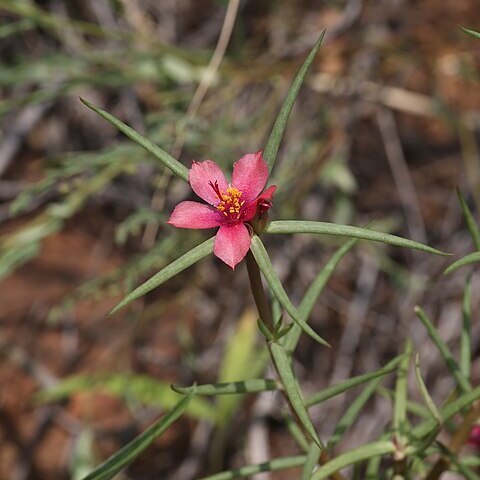Erect to ascending, slender succulent annual or short-lived perennial, branching above the base; stems up to 15(–28) cm high, rather stiffly ascending.. Leaves alternate, spaced, linear-terete, 9–25 mm long, 1–2 mm wide, sharply acute; axillary hairs in long shaggy tufts, sometimes indistinct, each axil also with 2 longer, brownish, hair-like scales with falcately-curving bases (these sometimes indistinct).. Flowers in terminal clusters of 3–6 or more, encircled by ± 8 involucral leaves enclosing dense woolly hairs, opening in the morning; involucral leaves longer than the cauline leaves, very variable in length, up to 30 mm long, slightly to much exceeding the flower cluster, spreading, finally slightly downturned.. Sepals 3–4.5 mm long, rounded on the back, keeled towards the acute apex with a slight crest; petals 5, usually bright red, occasionally orange-red, rose-pink or rarely yellow, 2.5–8 mm long, obovate-oblong, obtuse to acute; stamens (5–)8–13(–19); stigma (3–)4–5-branched.. Capsule 5 mm long, 2.5 mm in in diameter, dehiscing below the middle, lid a conical or rounded dome about as wide as high; seeds 0.5–0.75 mm long, metallic grey or occasionally silvery, the testa cells jigsaw-shaped to stellate, convex to conical.
More
Annual, occasionally perennial herb, up to 0.3 m high. Stems procumbent or erect. Leaves with blade linear to narrowly ovate, 30 x 3 mm; stipular hairs many, up to 7 mm long. Flowers: corolla bright carmine; Oct.-Mar.
Erect herb very similar to P. foliosa but stems always erect or suberect, the stipular hairs usually more persistent, more numerous and up to 7 mm. long.
Prostrate or erect herb, up to 200 mm tall. Leaves linear, cylindrical. Stipular hairs numerous, up to 7 mm long. Flowers magenta.
Petals bright carmine in colour and the stamen number varying from 10–25.
Dry sandy or gravelly soils among rocks; open woodland or margins of pans and seasonal swamps; Acacia-Commiphora bushland; in crevices of granite outcrops; at elevations from sea level to 2,200 metres.

